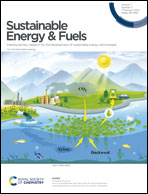Transient HCO/HCOO− species formation during Fischer–Tropsch over an Fe–Co spinel using low Ribblet ratio syngas: a combined operando IR and kinetic study†
Abstract
The comprehensive kinetics of simultaneous CO consumption in a Fischer–Tropsch and water–gas shift reaction network was systematically investigated over a supported FeCo2O4 spinel catalyst. An operando FTIR-MS study reveals hydrogen-assisted cleavage of the C–O bond through intermediate formyl (HCO) species formation over the spinel catalyst surface as the prominent route for hydrocarbon chain initiation in the Fischer–Tropsch process. In accordance, the Langmuir–Hinshelwood–Hougen–Watson model confirms that the first reaction of adsorbed hydrogen (CO* + H* ⇌ HCO* + *) is governed by equilibrium, while its second reaction (HCO* + H* ⇌ C* + H2O*) is kinetically controlled. Six reaction mechanisms comprising Fischer–Tropsch and water–gas shift rate expressions were developed. These models were initially discriminated based on their accuracy to fit the random experimental data collected using a laboratory scale high pressure plug flow reactor with negligible heat and mass transfer limitations, and realistic kinetic parameters were estimated using the Levenberg–Marquardt algorithm. The relatively lower percentage of deviation in the comprehensive model than in other literature-reported models ensures the preciseness of the predicted data. Our mechanistic model FT-III3/WGS-I postulates that the atomic hydrogen-assisted decomposition of surface intermediate HCO initiates the hydrocarbon chain on Fischer–Tropsch active sites, whereas in water–gas shift active sites, the reaction between adsorbed CO and associative H2O to form intermediate formate (HCOO*) species controls water–gas shift activity when syngas of a low Ribblet ratio is used as a feedstock under conventional Fischer–Tropsch process conditions.



 Please wait while we load your content...
Please wait while we load your content...